How to Create Content for Social Media Based on Consumer Insights And Performance Data
Learn how to create social media content that resonates by leveraging consumer insights and performance data. Uncover top strategies and tips.


If you want to make a real impact with my social media content, you need more than just ideas—you need a strategy that’s backed by data and shaped by what actually works in your industry.
Creating content for social is about more than filling a calendar; it’s about showing results, staying ahead of your competitors, and leading your team with confidence.
In this guide, I’ll walk through how to create social media content that's based on data, scalable approaches to improve your brand's content creation processes, and tips for creating content that not only stands out, but truly drives the outcomes yuor care about most.
Key takeaways
-
Why social media content creation should blend creativity with strategic thinking? This approach will ensure your social media content stands out while still driving meaningful, goal-aligned results.
-
How to create effective content for social media? A clear, step-by-step content creation framework—from audience research to performance monitoring—helps you stay consistent, organized, and always inspired.
-
What are some key tips for creating good content on social media? Great social content comes from leveraging platform insights, building a content vault, embracing video, and staying on top of trends that fit your brand.
-
What are the most common social media content mistakes that should be avoided? Avoiding copy-paste strategies and posting without a clear purpose is essential to creating authentic, effective content that truly reflects your brand.
Why social media content creation should blend creativity with strategic thinking?
When I’m planning content for social media, I know that creativity alone isn’t enough—and neither is strategy by itself. The magic really happens when I bring both together.
Creativity is what helps my content stand out. It’s the spark that grabs attention and makes my brand memorable in a crowded feed. But I’ve learned that if I focus only on being creative, without a clear plan or purpose, my results can be hit-or-miss. Great ideas are powerful, but they need direction.
That’s where strategy comes in. By grounding my creative work in a solid understanding of my audience, my goals, and what’s working in my industry, I make sure every post has a purpose. I can experiment confidently, because I know the “why” behind my choices. Whether I’m launching a new campaign or just trying a different style of video, my strategy keeps me focused on results—not just likes or trends, but growth and real business outcomes.
For me, the best social media content is the kind that feels fresh and exciting, but is also tailored to what my audience wants and what my brand stands for. Balancing creativity with strategic thinking is how I stay inspired, stay relevant, and keep driving real value—no matter what changes in the social world.
How to create content for social media in 9 easy steps
The trick is not simply to learn how to generate content, but how to create consistent content on social media. Building a framework for social media content generation will enable you to never run out of fresh ideas, no matter what social trends come and go.
So what are the main digital content creation tasks for social media, step by step? Let’s find out:
#1. Research your buyer persona’s pains and gains
When it comes to social media content creation, your work begins long before any posts land on your followers’ feeds.
To be able to produce quality content for social media, you need to do some serious research on target audience needs through surveys, customer interviews, and community listening.
You should strive to learn all you can about your audience: who they are, where they live, what they’re interested in, and so on. Only then can you start to create social media content that they can resonate with.
Every audience is different, and what resonates can change fast. Personally, I rely a lot on social listening, constantly to discover the topics my audience is talking about and how their perspectives change.
#2. Identify social media content gaps
Certainly, the insights I get from my audience's pain points research make a great starting point for content creation. However, I don’t want to create content in a bubble.
By checking in on what my competitors and industry leaders are posting—how they are framing different messages and which of their content gets real engagement—I can avoid stale ideas, get inspired and discover new best practices.
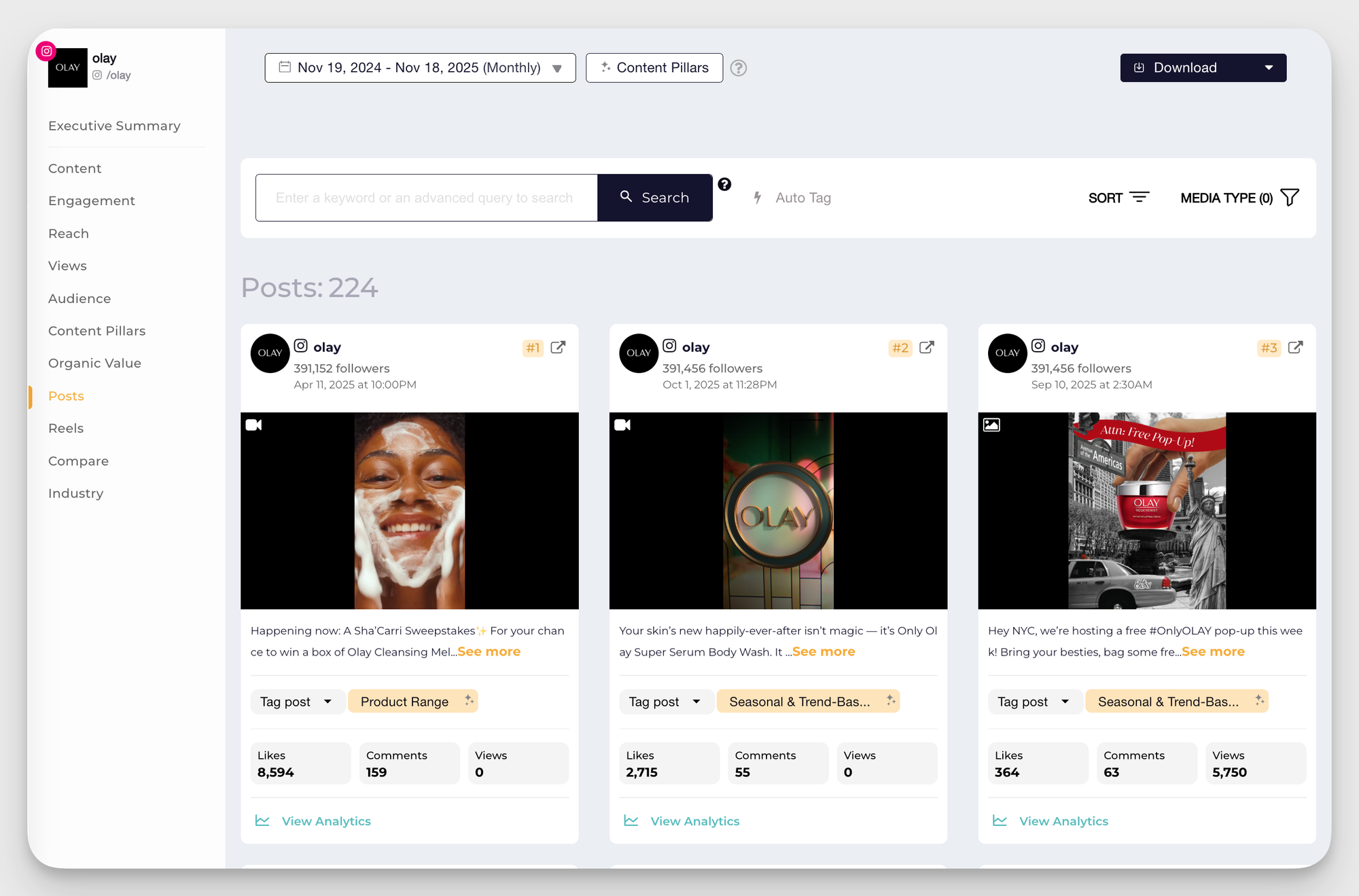
Sometimes the best spark comes from seeing something work (or flop) for someone else. Plus, I can spot gaps in their strategy that I can fill with my own unique approach.
#3. Set content goals
Setting social media goals is essential if you aim for a complete content creation process.
They can either be general (e.g., increase brand awareness, boost website traffic, grow your social media following) or platform-specific (such as getting more saves on your Instagram, more impressions on LinkedIn, or more views on TikTok).
At the end of the day, goals are simply milestones you expect your content to reach, so that you know you are on the right track. Different goals result in multiple forms of content creation.
#4. Brainstorm for creative ideas
Whenever I need fresh content ideas, I start by giving myself space to think big and think differently.
Sometimes, the best ideas come from unexpected places: a conversation with my team, a comment from a follower, or something I see a competitor doing that sparks a new angle. I make it a habit to jot down these sparks in a running list or content vault, so I always have inspiration to draw from.
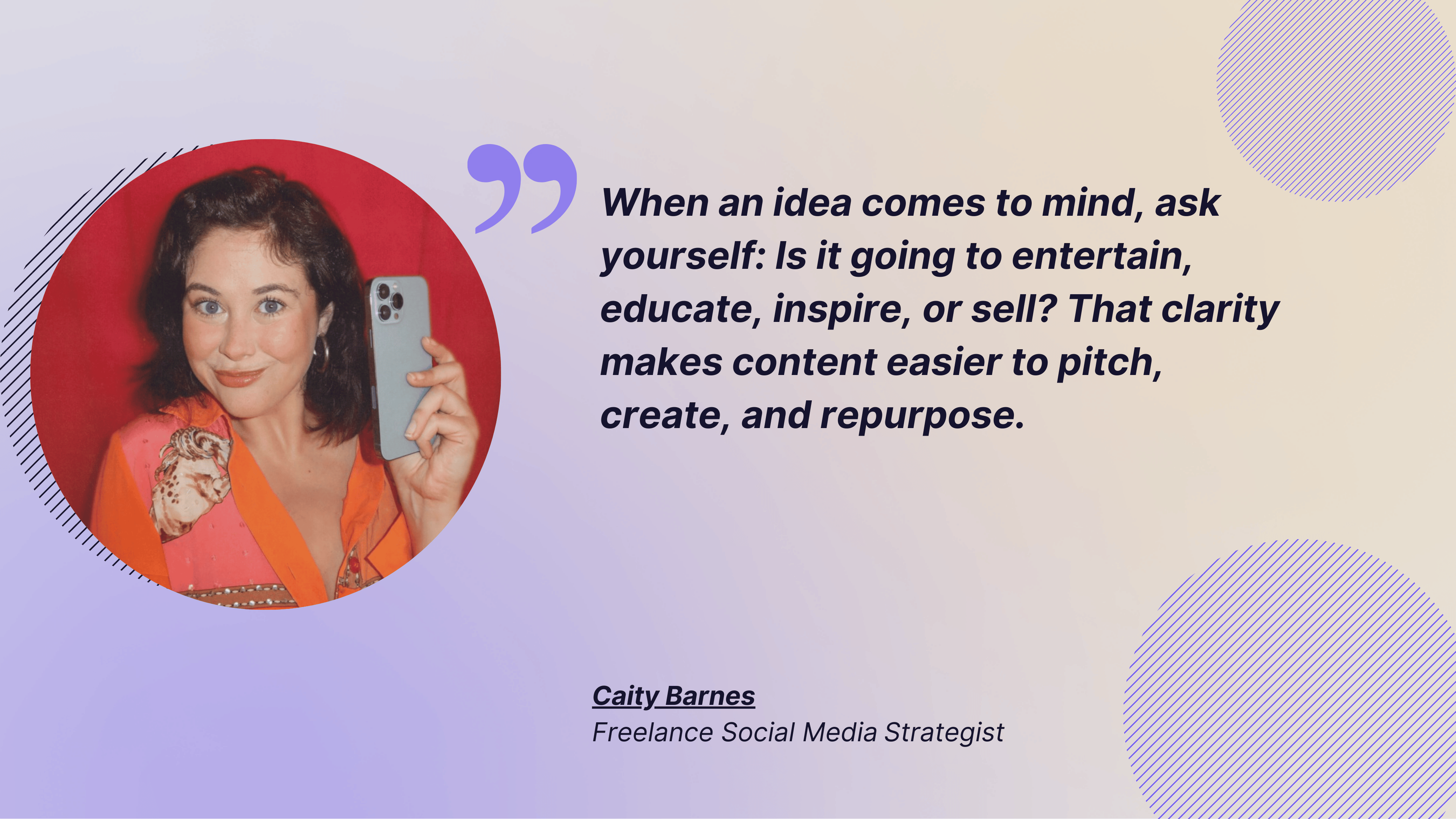
I also use data to guide my brainstorming. I’ll review which types of posts have performed well lately, then challenge myself to put a creative twist on those formats. And when I bring my unique voice and brand values into the mix, I know the ideas I come up with will not only stand out, but genuinely connect with the people I want to reach.
For me, creative brainstorming is about mixing inspiration, purpose, and a willingness to experiment—because that’s how I find ideas that keep my content engaging and effective.
These questions help you articulate your ideas and make them easier to sell to managers or clients. The more you practice this framework, the simpler content creation becomes.
#5. Define and adjust your content pillars whenever needed
It’s easy to get stuck posting the same types of content over and over—or scrambling for new ideas at the last minute.
That’s why I use content pillars: a handful of themes that really connect with my audience and represent what my brand stands for. With a content vault (a simple doc or spreadsheet), I can collect and tag ideas, evergreen content, and inspiration.
Having this organized system helps me keep my feed balanced, my voice consistent, and reporting—when I need to share results with my team—even easier.

#6. Create your content calendar
With a few definitive social media content pillars under your belt, you can start to create a content calendar for your social media platforms.
Ideally, you would have a unique calendar per platform, but if your social media strategy includes a lot of cross-posting and content recycling, then it makes sense to put everything in one place.
In any case, learning how to create a content calendar for social media is a very important part of your job as a social media specialist.
With a content calendar, you can plan posts ahead of time and have a bird’s eye view of your post distribution throughout the month.
To automate this process further, you can also use a social media management tool that will help with scheduling content and even provide additional features such as analytics and reporting.
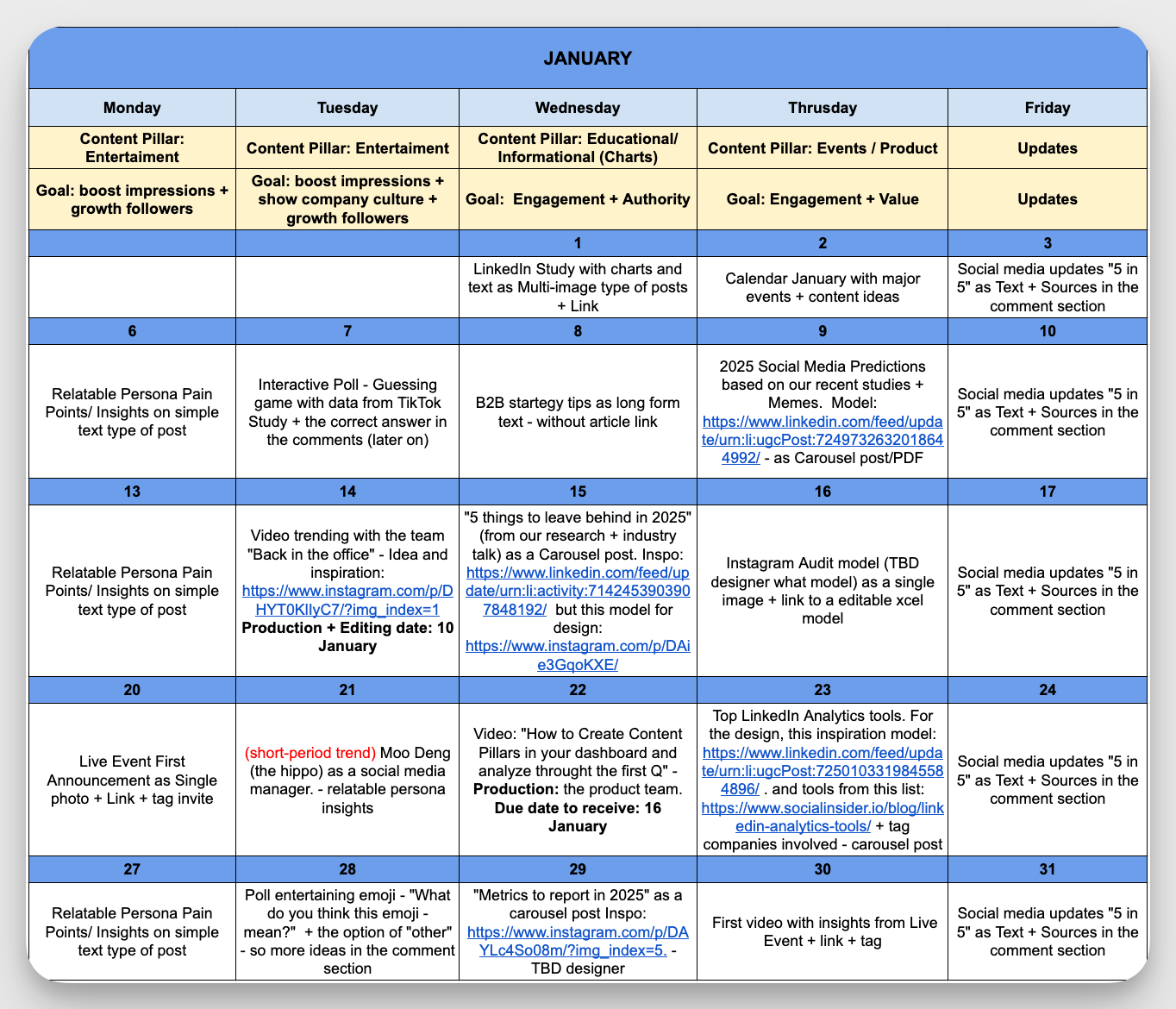
#7. Learn to master content repurposing
Think of your brand like a person with one voice that adapts to different settings. You speak differently at work versus with friends, but your core personality remains the same. Apply this concept to your content across platforms as well.
From one piece of content (like a webinar), you can create multiple spin-offs to support the original content:
- For LinkedIn: long-form summary posts
- For YouTube Shorts: 90-second engaging clips
- For TikTok: multiple short clips highlighting different points
- For Instagram: carousel posts and Reels
Create detailed personas for each platform, understanding not just demographics but the specific needs and pain points your audience has on each channel. Then, tailor your repurposed content to address these platform-specific needs.
And make sure to revisit your content library from 6+ months ago as well. It’s not mandatory for content to always be fresh because social media moves so fast that less than half your audience likely saw the original post. Repackage that content in different formats and give it new life.
#8. Prepare posts for publishing
Before publishing, you should make sure everything is in its place. Depending on the type of post you’re sharing, you may need to prepare visual materials such as images, infographics, or videos.
To make things easier for you, you can create a social media post checklist and populate it with all the necessary elements of a successful post, such as:
- A catchy headline
- Relevant campaign hashtags
- Attractive visuals
- Strong CTAs
- Useful links
Then, as you’re making content for social media, you can simply check off every item as you add it to your post.
#9. Adjust your strategy based on results
Your best source of social media content inspiration is your own data. To be able to create business content for social media, you need to understand what works and what doesn’t.
To start making data-driven decisions regarding your content on social media, you can rely on a social media analytics tool like Socialinsider to do all the heavy lifting.
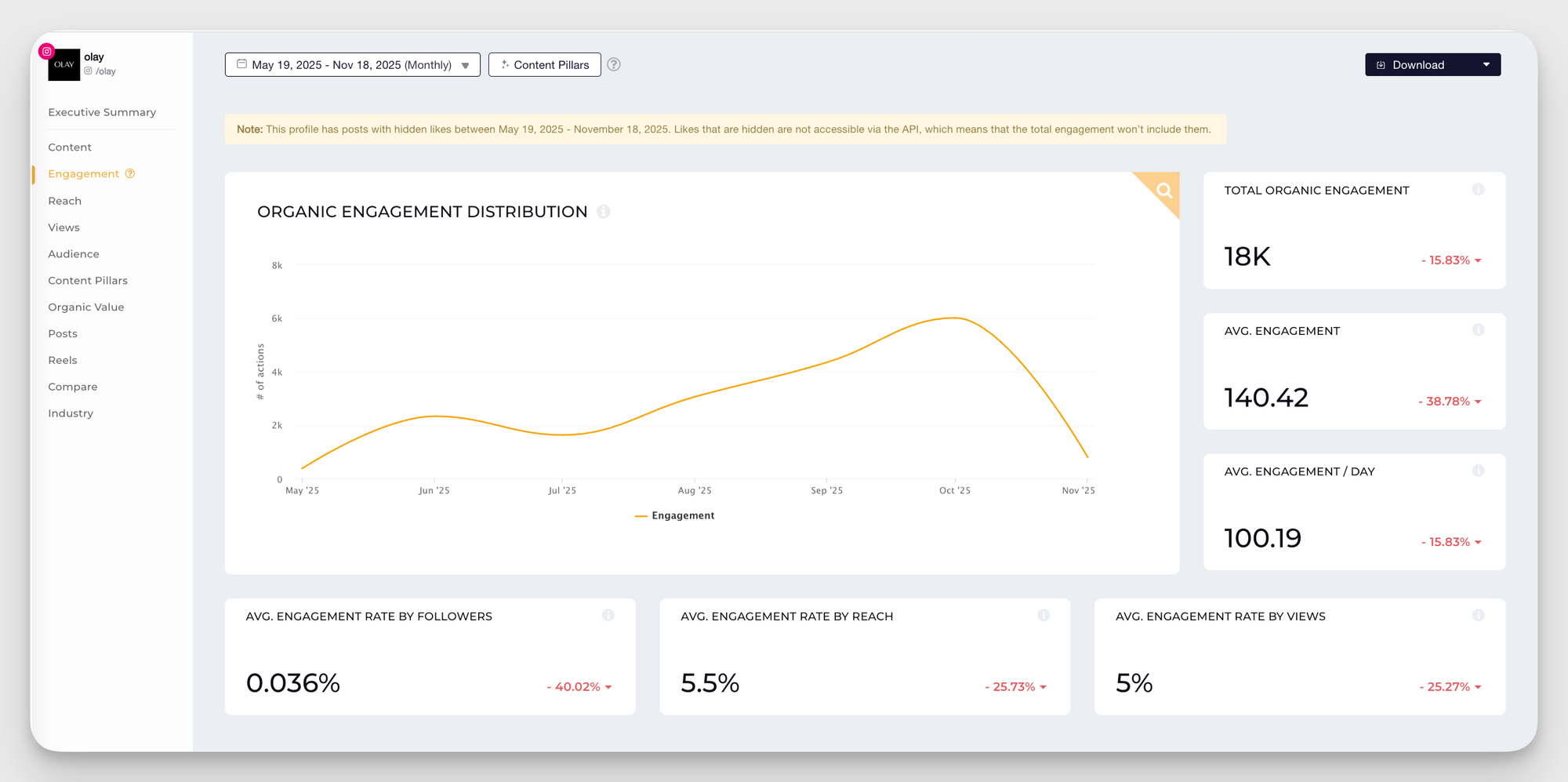
Once you add your social profiles in our app, the possibilities are endless. You can do advanced competitive analysis and benchmarking, compare campaign performance, get powerful individual or brand-level post insights, and download pitch-ready reports to present to your team or clients.
And here's the opinion of one of our clients after trying Socialinside:
"The user interface and just the general UX with it is quite straightforward, which compared to the complexity of other ones is much appreciated." - Chris from Axel Springer
When it comes to figuring out what type of content performs best, you can rely on the Posts section to sort posts by key metrics (engagement, reach, impressions, and other channel-specific KPIs) so that you can see what content resonated the most with your audience and where you can improve.
Tip: Look beyond basic engagement metrics to understand the full story:
- Watch time and retention: How long do people actually stay engaged?
- Saves and shares: High saves indicate valuable, reference-worthy content
- Share patterns: Heavily shared content is often relatable and resonates emotionally
Use competitor content pillar analysis to identify gaps in your strategy. Look at what content pillars drive the most engagement in your industry and spot topics your competitors aren’t covering enough.
Essential tips for creating good content on social media
We live in a world ruled by content. Quality content. People expect to read exciting topics every day, see creative posts, and feel like they are part of a community.
Unfortunately, the main disadvantage of the social media ecosystem is that thousands of posts are added per second.
And there’s another thing any content creator for social media should take into consideration: users tend to easily forget the information they read or see on these channels.
Creating high-performing social media content can be challenging and time-consuming.
But here we have 3 key tips that can drastically improve your efforts and help speed up and simplify social media content development.
Get content and strategy ideas from your target platform
As a social media manager, you need all the help you can get to learn how to create content for social media. Not just any kind of content, but quality content that makes a splash and brings in more awareness and potential customers for your brand.
An underrated trick that will drastically improve your content creation for social media is to look at all social media channels as more than the place where you publish content. Instead, you need to see them as your primary source of first-hand, tried-and-tested content and strategy ideas.
So, for example, if you need ideas for your Instagram content, go on Instagram and look for content & strategy videos. If you’re unsure how to take your TikTok content to the next level, go on TikTok and listen to what first-hand users of TikTok are saying.
To make sure the right kind of content lands in your feed or explore page, you can look for and follow other social media managers, as well as agency owners, solopreneurs, or brands whose social media content you admire.

Create a content vault to store your best ideas
The trick is to optimize content creation for social media to the point where you never have to start from scratch. To do this, a great idea would be to build a content vault, where you organize all the content ideas you collect by content pillar.
You can do this using a productivity app like Notion, but it also works in Google Spreadsheets or other similar tools.
Vanessa Lau, content creator and business mentor, provides a ton of great ideas on how to create consistent content on social media, including content matrices and content vaults.
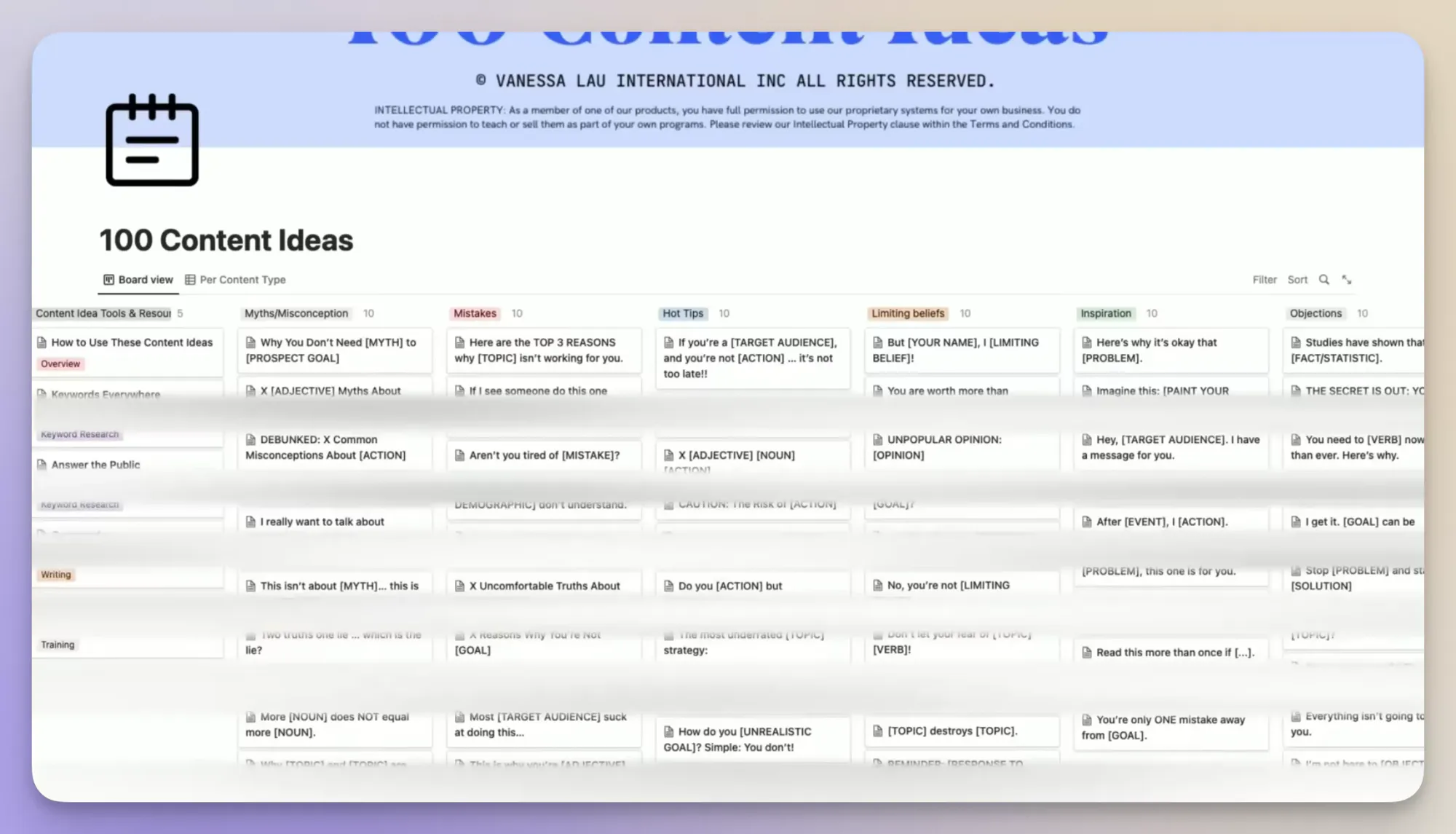
Embrace the power of video
There’s no doubt that we’re moving into the era of video. TikToks, YouTube Shorts, and Instagram Reels are getting massive amounts of engagement and for good reason.
What’s more, stories are told more efficiently and authentically with video. Why? Users prefer to watch a video rather than read an article and get lost throughout the text when seeking information.
It’s just a quicker and easier way to learn everything about anything.
With that in mind, choosing to develop a strong video marketing strategy should be a no-brainer. For that to happen, you first need to learn how to create video content for social media and have a solid library of video content ideas ready to go.
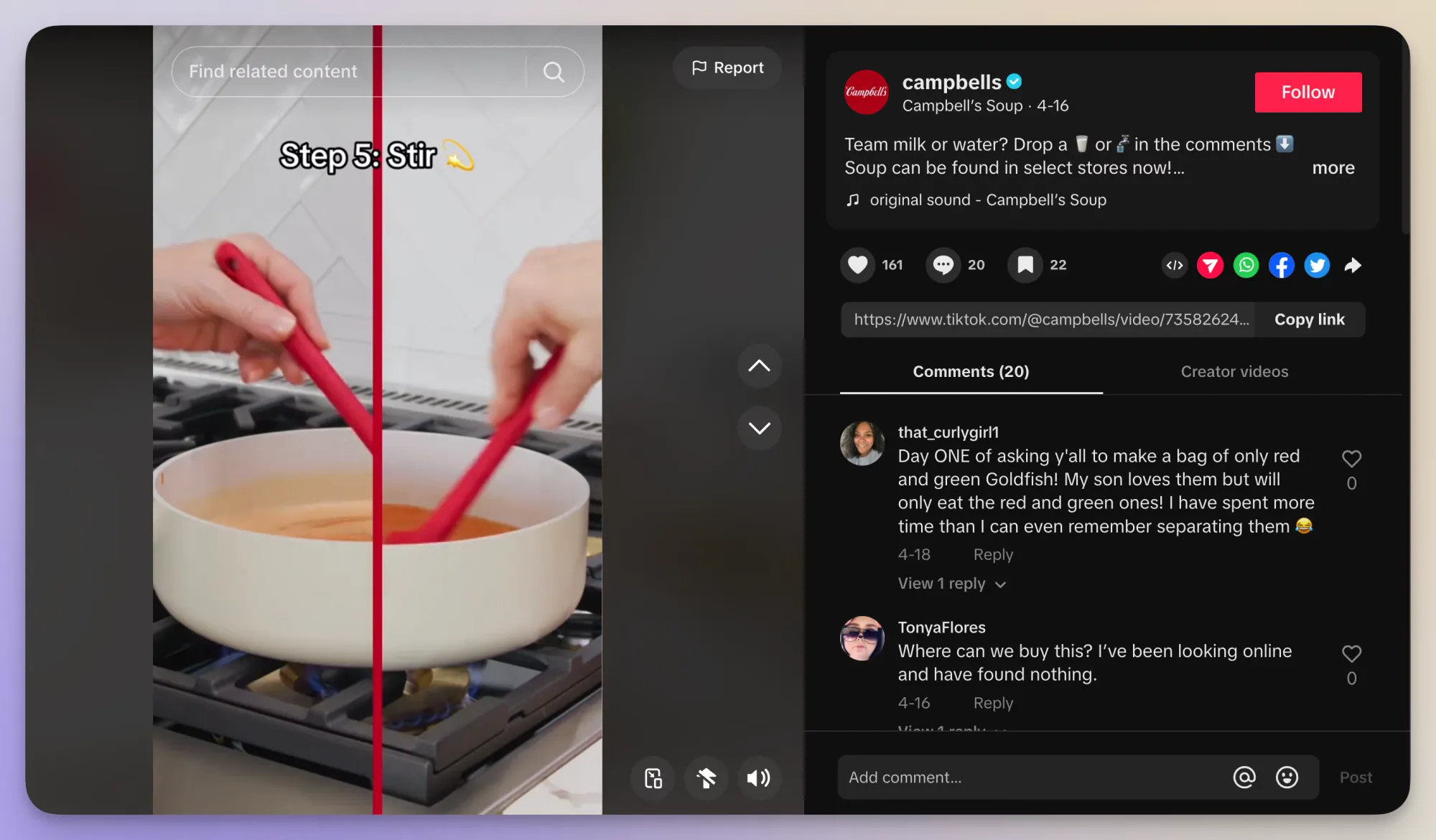
Keep an eye on the latest trends
In your journey on how to create engaging content for social media, you soon learn that following the latest social media trends is an important practice.
You don’t necessarily have to join all of them, but it’s important to know what’s trending and how you can adjust some of the trends to fit into your brand’s social media strategy.
There’s nothing worse than a brand being a week late to a trend. If it doesn’t make sense for your brand, don’t force it. - Caity Barnes, Freelance Social Media Strategist
TikTok is one of those platforms where new trends emerge every single day, so if you want to take full advantage of them, you need to act fast. If done right, TikTok trends can definitely be your ticket to virality.
Instagram is another place where trends come and go pretty fast. Maybe more so than on TikTok, for Reels, you need to pay special attention to Instagram trending audios and use them to perfectly complement your video posts.
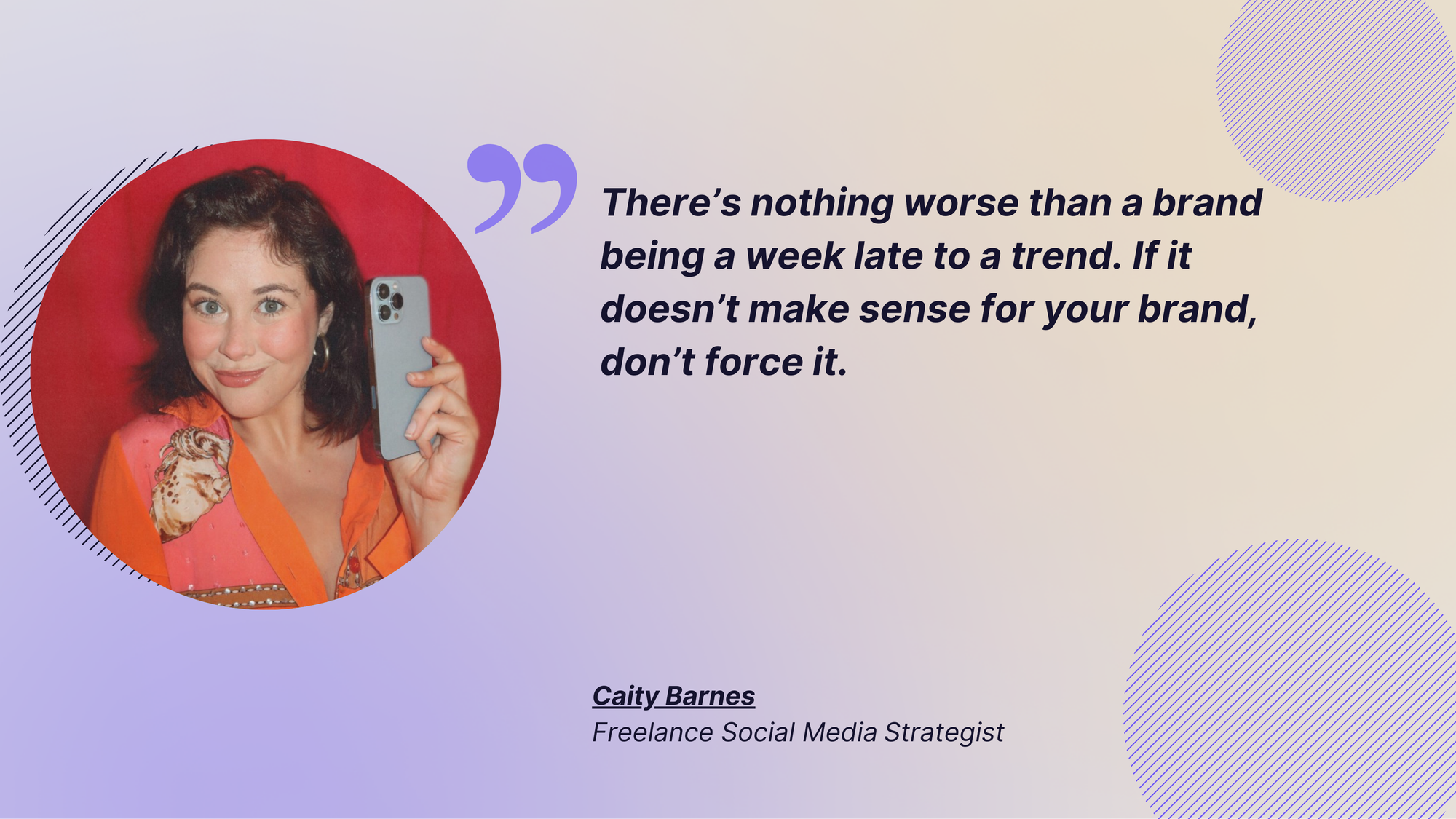
Common social media content mistakes to avoid
Before diving into the content creation process, it’s crucial to understand what NOT to do. Many brands fall into one of these two common traps:
Following other brands’ playbooks without strategy
One of the biggest mistakes brands make is copying the “chronically online voice” that worked for brands like Wendy’s or Duolingo without developing their own original strategy. While this approach worked when only a few brands were doing it, it now feels inauthentic and dystopian when everyone uses the same copy-and-pasted strategy.
Ryanair is another example. But the thing is, Ryanair knows its audience very well. They know people are not over the moon with the services provided, and that they voice their opinions online every chance they get. There’s no point in painting a different picture, so they’ve pivoted their content and brand voice accordingly. However, if other brands tried to do a 180 and copy them, it would only come across as rude or trying too hard; it would definitely not have the same effect.
A mistake I see brands making is only going by the playbooks of what they're seeing well with other brands. Having a purpose on social media and knowing that purpose is so important in the content creation process - Caity Barnes, Freelance Social Media Strategist
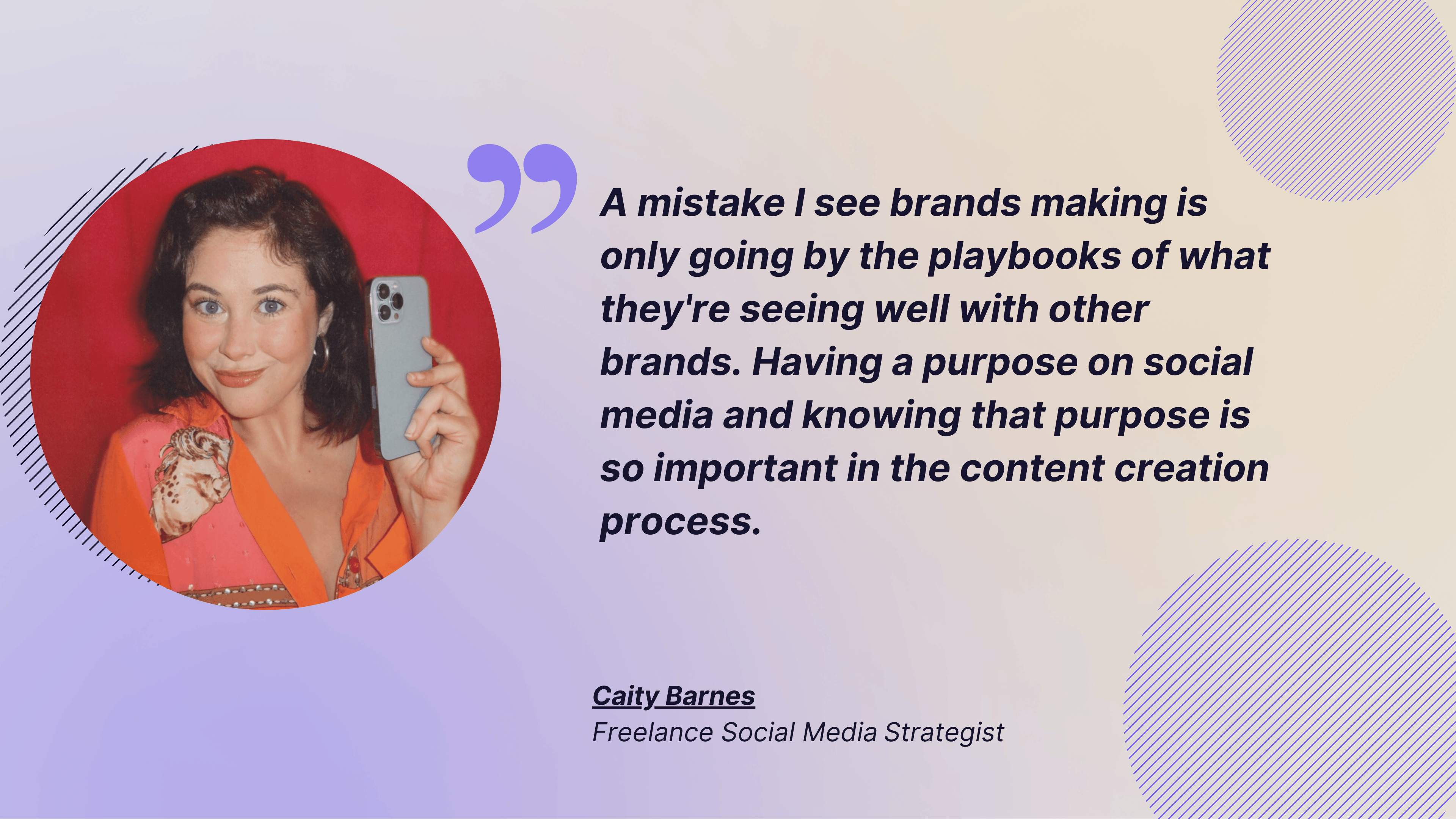
Lack of clear purpose
Many brands create content without knowing their purpose on social media. Every piece of content should ladder up to a bigger brand purpose. Social media is an extension of your brand, so it needs to clearly communicate what your brand stands for, not just follow someone else’s playbook.
Final thoughts
At the end of the day, what matters most to me is knowing that every piece of content I create actually moves the needle—not just for my brand, but for the people I want to reach. Blending creativity with strategic thinking, staying plugged into data, and learning from what works (and doesn’t) in my industry gives me the confidence to lead with purpose.
Social media will always be changing, but when I ground my approach in clear goals, smart analysis, and meaningful creativity, I can adapt and thrive—no matter what’s trending. It’s not about chasing every new idea; it’s about building a process that lets me deliver real, measurable results again and again. That’s how I make my mark as a content leader and truly stand out in a crowded digital world.
FAQs on how to create content for social media
What makes good social media content?
The definition of good social media content can differ based on your goals, but generally, good social content is the type of content that makes people stop scrolling to engage with. That means your post offers value, makes them feel something, or inspires them to take an action (click on a link, go on your website, book a demo, etc).
Analyze your competitors in seconds
Track & analyze your competitors and get top social media metrics and more!
You might also like
Improve your social media strategy with Socialinsider!
Use in-depth data to measure your social accounts’ performance, analyze competitors, and gain insights to improve your strategy.





